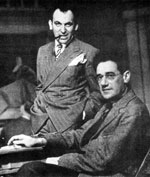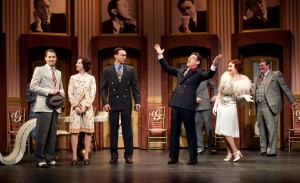Today’s Wall Street Journal drama column is devoted in its entirety to an important regional revival of Once in a Lifetime in Sarasota, Florida. Here’s an excerpt.
* * *
 If you’re a theater buff with a serious interest in American comedy, “Once in a Lifetime” probably ranks high on the list of little-known shows you’d love to see onstage. Otherwise, I doubt you’ve heard of it. A farce about the coming of talking pictures to Hollywood, “Once in a Lifetime” was the first collaboration between George S. Kaufman and Moss Hart, who went on to write “The Man Who Came to Dinner” and “You Can’t Take It With You.” It opened on Broadway in 1930 and ran for 406 performances, which was big business back then. Two years later, it was turned into a middling movie, then vanished from sight (the 1979 Broadway revival was a flop). Today the play is known solely because Mr. Hart wrote about how it came to Broadway in “Act One,” his 1959 autobiography.
If you’re a theater buff with a serious interest in American comedy, “Once in a Lifetime” probably ranks high on the list of little-known shows you’d love to see onstage. Otherwise, I doubt you’ve heard of it. A farce about the coming of talking pictures to Hollywood, “Once in a Lifetime” was the first collaboration between George S. Kaufman and Moss Hart, who went on to write “The Man Who Came to Dinner” and “You Can’t Take It With You.” It opened on Broadway in 1930 and ran for 406 performances, which was big business back then. Two years later, it was turned into a middling movie, then vanished from sight (the 1979 Broadway revival was a flop). Today the play is known solely because Mr. Hart wrote about how it came to Broadway in “Act One,” his 1959 autobiography.
Why doesn’t anybody do “Once in a Lifetime” nowadays? It costs too much–way too much. The published script calls for five sets and 38 actors. You could get away with that in the Thirties, but no commercial producer would think of bringing so horrendously expensive a play to Broadway anymore. Enter San Francisco’s American Conservatory Theater and Sarasota’s Asolo Repertory Theatre, two regional companies that double as drama schools, making it possible for them to put on large-cast shows by using students to cover smaller parts. A.C.T. mounted “Once in a Lifetime” last fall and Asolo Rep is doing it now, and both versions, not coincidentally, were directed by the same man, Mark Rucker.
Since the two productions are identical in concept–most of the members of the cast play double, triple and quadruple roles–I tossed a coin and elected to see “Once in a Lifetime” at Asolo Rep, whose version makes use of 19 actors, four more than at A.C.T. It was worth the trip. “Once in a Lifetime” proves to be as fresh as any of the later screwball comedies on whose screenplays it surely left a mark (not to mention “Singin’ in the Rain,” whose authors, Betty Comden and Adolph Green, must have had it in mind).
 “Once in a Lifetime” is the story of George, Jerry and May (Jason Bradley, Andrew Carter and Hillary Clemens), a trio of small-time vaudeville hoofers who see the premiere of “The Jazz Singer” in New York and decide to go to Hollywood, pass themselves off as authorities on elocution and make their fortune by teaching silent-movie actors how to talk….
“Once in a Lifetime” is the story of George, Jerry and May (Jason Bradley, Andrew Carter and Hillary Clemens), a trio of small-time vaudeville hoofers who see the premiere of “The Jazz Singer” in New York and decide to go to Hollywood, pass themselves off as authorities on elocution and make their fortune by teaching silent-movie actors how to talk….
This premise is so familiar that you have to remind yourself that Kaufman and Hart were the first writers ever to turn it into a plot. Part of what makes “Once in a Lifetime” more than just a historical curiosity is the jaundiced wit with which the characters comment on the head-banging craziness that surrounds them. (Jerry, working a crossword puzzle: “What’s a four-letter word for actor?” May: “Dope.”) But mere wisecracks won’t make a play fly. That’s where craftsmanship comes in, and the authors of “Once in a Lifetime” knew their stuff. Every piece of the puzzle fits together with a crisp, satisfying click…
Ms. Clemens, who gave a poignant performance as the tomboy in Writers’ Theatre’s 2008 Chicago revival of “Picnic,” plays May as a spunky, cloche-hatted girl-next-door who knows how to snap off a punch line, which is just right….
* * *
Read the whole thing here.
The 1932 film adaptation of Once in a Lifetime:
Aline MacMahon, who plays May, created the role in the original Brighton Beach tryout of the stage version, but was replaced on Broadway by Jean Dixon. She later appeared in the play’s Los Angeles premiere.
Archives for February 10, 2012
TT: Almanac
“The patience most people have for someone else’s grief is short-lived. The display of a measured grief is comforting. It implies order, and even benevolence (for being designed of sensible proportions) to process of life that we don’t understand well, can understand only if we have gone through them. Profound grief suggests mysteries at the heart of human existence that cannot be prepared for, which can come at any time, and into any life.”
Alec Wilkinson, A Violent Act
